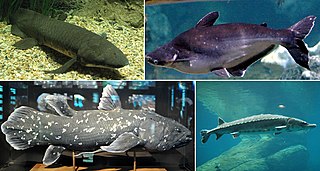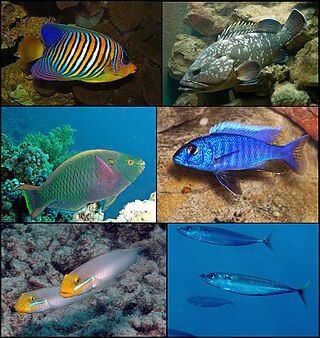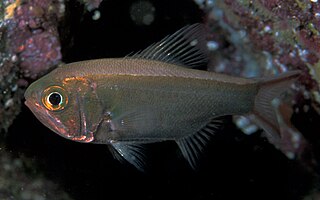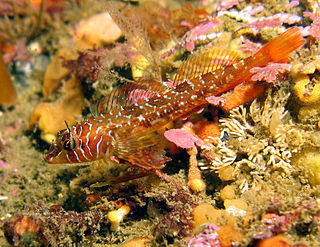Related Research Articles

Osteichthyes, commonly referred to as the bony fish, is a diverse superclass of vertebrates that have skeletons primarily composed of bone tissue. They can be contrasted with the Chondrichthyes, which have skeletons primarily composed of cartilage. The vast majority of fish are members of Osteichthyes, which is an extremely diverse and abundant group consisting of 45 orders, and over 435 families and 28,000 species. It is the largest class of vertebrates in existence today. The group Osteichthyes is divided into the ray-finned fish (Actinopterygii) and lobe-finned fish (Sarcopterygii). The oldest known fossils of bony fish are about 425 million years old, which are also transitional fossils, showing a tooth pattern that is in between the tooth rows of sharks and bony fishes.

Perciformes, also called the Percomorpha or Acanthopteri, is an order or superorder of ray-finned fish. If considered a single order, they are the most numerous order of vertebrates, containing about 41% of all bony fish. Perciformes means "perch-like". Perciformes is an order within the Clade Percomorpha consisting of "perch-like" Percomorphans. This group comprises over 10,000 species found in almost all aquatic ecosystems.

Characiformes is an order of ray-finned fish, comprising the characins and their allies. Grouped in 18 recognized families, more than 2000 different species are described, including the well-known piranha and tetras.

The Osmeriformes are an order of ray-finned fish that includes the true or freshwater smelts and allies, such as the galaxiids and noodlefishes; they are also collectively called osmeriforms. They belong to the teleost superorder Protacanthopterygii, which also includes pike and salmon, among others. The order's name means "smelt-shaped", from Osmerus + the standard fish order suffix "-formes". It ultimately derives from Ancient Greek osmé + Latin forma, the former in reference to the characteristic aroma of the flesh of Osmerus.

Rhamphocottidae is a family of ray-finned fishes belonging to the superfamily Cottoidea, the sculpins. The species in this family occur in the North Pacific Ocean.

Caproidae, or boarfishes, are a small family of marine fishes comprising two genera and 12 species. They were formerly placed in the order Zeiformes with the dories, but were later moved to Perciformes based on percoid characteristics of the caudal skeleton and other morphological evidence. More recent revisions of Percomorpha have seen them placed in Caproiformes or Acanthuriformes. Boarfishes are native to the Indian, Atlantic, and Pacific Oceans, where they are mainly found at depths below 50 m (160 ft).

Trachiniformes is an order of percomorph bony fish, whose contents are traditionally pllaced in suborder Trachinoidei of Perciformes.
Acanthomorpha is an extraordinarily diverse taxon of teleost fishes with spiny rays. The clade contains about one-third of the world's modern species of vertebrates: over 14,000 species.

Alepocephaliformes is an order of ray-finned fish. It was previously classified as the suborder Alepocephaloidei of the order Argentiniformes.

Percomorpha is a large clade of ray-finned fish that includes the tuna, seahorses, gobies, cichlids, flatfish, wrasse, perches, anglerfish, and pufferfish.

The Neoteleostei is a large clade of bony fish that includes the Ateleopodidae (jellynoses), Aulopiformes (lizardfish), Myctophiformes (lanternfish), Polymixiiformes (beardfish), Percopsiformes (Troutperches), Gadiformes (cods), Zeiformes (dories), Lampriformes, and the populous clade of the Acanthopterygii which includes the Beryciformes (squirrelfish) and the Percomorpha.

Otocephala is a clade of ray-finned fishes within the infraclass Teleostei that evolved some 230 million years ago. It is named for the presence of a hearing (otophysic) link from the swimbladder to the inner ear. Other names proposed for the group include Ostarioclupeomorpha and Otomorpha.

The Trachichthyiformes are an order of ray-finned fishes in the superorder Acanthopterygii.

Callionymiformes is an order of bony fish containing two families, the dragonets Callionymidae and the Draconettidae. In some taxonomies these families make up the suborder Callionymoidei of the wider grouping known as Perciformes, Nelson (2016) recognised the order but subsequent workers have suggested that if Callionymiformes is recognised as an order then the order Syngnathiformes is rendered paraphyletic and include Callionmyoidei within that taxon.

Scombriformes is an order of bony fish containing nine families which were classified under the suborders Scombroidei and Stromateoidei, of the wider grouping known as Perciformes, Fishes of the World, 5th ed. (2016), recognised the order but subsequent workers have suggested that Scombriformes forms part of the larger Pelagiaria clade.

Aulostomoidei is a suborder of the order Syngnathiformes, which also contains groups such as the seahorses, pipefishes and dragonets.

Aulostomoidei is a superfamily of the order Syngnathiformes, which also contains groups such as the seahorses, pipefishes and dragonets. It is one of two superfamilies which make up the suborder Aulostomoidei within the Syngnathiformes.

Centriscoidea is a superfamily of the suborder Aulostomoidei, part of the order which includes the sea horses, pipefishes and dragonets, the Syngnathiformes. They are characterised by having the 5-6 anterior vertebrae being elongated and the pelvic fin has a single spine and four rays.

Jordaniidae is a small family of marine ray-finned fishes belonging to the order Scorpaeniformes. These fishes are found in the eastern North Pacific Ocean.
References
- ↑ "Phylogeny of all Fishes". Deepfin. Archived from the original on 7 March 2022. Retrieved 1 December 2019.
- 1 2 Betancur-R., Ricardo; Broughton, Richard E.; Wiley, Edward O.; Carpenter, Kent; López, J. Andrés; Li, Chenhong; Holcroft, Nancy I.; Arcila, Dahiana; Sanciangco, Millicent; Cureton II, James C; Zhang, Feifei; Buser, Thaddaeus; Campbell, Matthew A.; Ballesteros, Jesus A; Roa-Varon, Adela; Willis, Stuart; Borden, W. Calvin; Rowley, Thaine; Reneau, Paulette C.; Hough, Daniel J.; Lu, Guoqing; Grande, Terry; Arratia, Gloria; Ortí, Guillermo (2013). "The Tree of Life and a New Classification of Bony Fishes". PLOS Currents. 5. doi: 10.1371/currents.tol.53ba26640df0ccaee75bb165c8c26288 . ISSN 2157-3999. PMC 3644299 . PMID 23653398.
- 1 2 3 Betancur-R, Ricardo; Wiley, Edward O.; Arratia, Gloria; Acero, Arturo; Bailly, Nicolas; Miya, Masaki; Lecointre, Guillaume; Ortí, Guillermo (2017). "Phylogenetic classification of bony fishes". BMC Evolutionary Biology. 17 (1): 162. doi: 10.1186/s12862-017-0958-3 . ISSN 1471-2148. PMC 5501477 . PMID 28683774.